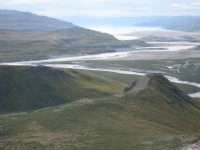CSDMS groups
CSDMS Groups
Working Groups
CSDMS currently has five Working Groups, which includes three environmental (or discipline) working groups, two integrative working groups, six focus research groups and two initiatives. As of June, 2013, membership came from 123 U.S. universities, 21 U.S. Federal Labs, 22 U.S. corporations, 275 foreign research institutions from more than 65 different countries, (see also member distribution per country). Working groups typically meet once per year, coordinating much of their activity via remote communication systems. Chairs of the Working Groups form the Executive Committee of CSDMS.
Learn more about the charge of the working groups (PDF file).
- Terrestrial Working Group (Chair, Greg Tucker), 1202 members, weathering, hillslope, fluvial, glacial, aeolian, lacustrial
- Coastal Working Group (Chair, Brad Murray), 914 members, delta, estuary, bays and lagoons, nearshore
- Marine Working Group (Chair, Courtney Harris), 550 members, shelf, carbonate, slope, deep marine
- Education and Knowledge Transfer (EKT) Working Group (Chair, Wei Luo), 412 members, targeting researchers with model & visualization tools; planners with decision-making tools; and educators with pre-packaged models to help illustrate surface processes, tools to build intuition.
- Cyberinformatics and Numerics Working Group (Chair, Tian-Jian (Tom) Hsu; Vice-chair, Scott Peckham), 346 members includes technical computational aspects of the CSDMS, ensures that the modeling system properly functions and is accessible to users; software protocols are maintained, along with model standardization and visualization; works with our cyberinformatic partners.
Focus Research Groups
CSDMS currently has seven Focus Research Groups or FRGs. FRGs differ from Working Groups in that they serve a unique subset of our surface dynamics community, and usually represent a well-developed community. FRGs are often co-sponsored by another organization. FRGs are similarly supported by the CSDMS Integration Facility as Working Groups, including access to CSDMS High Performance Computers. FRG's typically meet once per year, coordinating much of their activity via remote communication systems. Chairs of FRGs report directly to the CSDMS Executive Director, and often to the Chair or Director of the co-sponsoring organization.
- Hydrology Focus Research Group, 966 members, represents the hydrological modeling community, and is being co-sponsored by CUAHSI. This FRG deals with aspects of the hydrological system that impact earth-surface dynamics. (Chair, Jon Goodall)
- Carbonate Focus Research Group, 0 members, is the outgrowth of the recent NSF effort to coordinate the carbonate modeling community and their development of a numerical carbonate workbench (Chair, Peter Burgess)
- Chesapeake Focus Research Group, 140 members, is our first 'geographically-focused' effort representing and co-sponsored by the Chesapeake Community Modeling Program, with their unique collection of models and field data set (Chair, Raleigh Hood)
- Geodynamics Focus Research Group, 399 members. represents the geodynamic modeling community, and is being co-sponsored by GeoPRISMS. This FRG deals with aspects of the geodynamic system that impact earth-surface. (Chair, Phaedra Upton and Mark Behn)
- Critical Zone Focus Research Group, 258 members, is originated to develop compatibility between CSDMS architecture & protocols and developed models & data produced by the co-sponsor Critical Zone Observatory (Chair, Chris Duffy and Lejo Flores)
- Human Dynamics Focus Research Group, 0 members. (Chair, Kathleen Galvin and Mark Rounsevell)
- Ecosystem Dynamics Focus Research Group, 394 members. (Chair, Brian Fath)
Initiatives
CSDMS hosts two initiatives to advance earth-surface process modeling across disciplines. The Initiatives will connect researchers, and supports focused research on pressing scientific questions proposed by our research community and involve partnerships with scientists in the fields of ecology, global sustainability, coastal vulnerability and continental margin dynamics.
- Coastal Vulnerability, 311 members, represents the Coastal Vulnerability modeling community. This initiative deals with aspects of coastal vulnerability with emphasis on deltas and their multiple threats and stresses. (Chair, Brad Murray)
- Continental Margin Initiative, 159 members,represents the Continental Margin modeling community. The goal of this initiative is to model extreme oceanic and atmospheric events on generating turbidity currents in the Gulf of Mexico. (Chair, Courtney Harris)
Groups Area
The links below will guide you to the different group web sites. Each community has its own web site set up, such to pursue their goals the best.
| Chair | Working Groups (WG) / Focus Research Groups (FRG) | Members |
|---|---|---|
| Greg Tucker | Terrestrial WG | 1202 Members |
| Brad Murray | Coastal WG | 914 Members |
| Courtney Harris | Marine WG | 550 Members |
| Wei Luo | Education and Knowledge Transfer (EKT) WG | 412 Members |
| Tian-Jian (Tom) Hsu | Cyberinformatics and Numerics WG | 346 Members |
| Jon Goodall | Hydrology FRG | 966 Members |
| Peter Burgess | Carbonate FRG | 0 Members |
| Carl Friedrichs | Chesapeake FRG | 140 Members |
| Phaedra Upton and Mark Behn | Geodynamics FRG | 399 Members |
| Chris Duffy and Lejo Flores | Critical Zone FRG | 258 Members |
| Kathleen Galvin and |Mark Rounsevell | Human Dynamics FRG | 0 Members |
| Brian Fath | Ecosystem Dynamics FRG | 394 Members |
| Brad Murray | Coastal Vulnerability Initiative | 311 Members |
| Courtney Harris | Continental Margin Initiative | 159 Members |
| All members of CSDMS |

